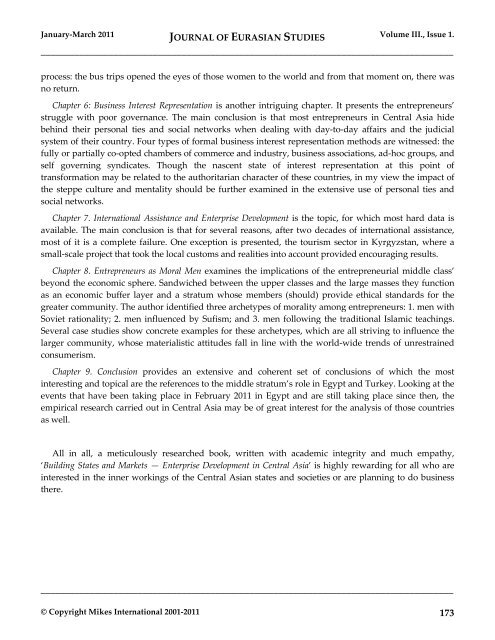JOURNAL OF EURASIAN STUDIES
JOURNAL OF EURASIAN STUDIES
JOURNAL OF EURASIAN STUDIES
Create successful ePaper yourself
Turn your PDF publications into a flip-book with our unique Google optimized e-Paper software.
January-March 2011 <strong>JOURNAL</strong> <strong>OF</strong> <strong>EURASIAN</strong> <strong>STUDIES</strong> Volume III., Issue 1.<br />
_____________________________________________________________________________________<br />
process: the bus trips opened the eyes of those women to the world and from that moment on, there was<br />
no return.<br />
Chapter 6: Business Interest Representation is another intriguing chapter. It presents the entrepreneurs’<br />
struggle with poor governance. The main conclusion is that most entrepreneurs in Central Asia hide<br />
behind their personal ties and social networks when dealing with day-to-day affairs and the judicial<br />
system of their country. Four types of formal business interest representation methods are witnessed: the<br />
fully or partially co-opted chambers of commerce and industry, business associations, ad-hoc groups, and<br />
self governing syndicates. Though the nascent state of interest representation at this point of<br />
transformation may be related to the authoritarian character of these countries, in my view the impact of<br />
the steppe culture and mentality should be further examined in the extensive use of personal ties and<br />
social networks.<br />
Chapter 7. International Assistance and Enterprise Development is the topic, for which most hard data is<br />
available. The main conclusion is that for several reasons, after two decades of international assistance,<br />
most of it is a complete failure. One exception is presented, the tourism sector in Kyrgyzstan, where a<br />
small-scale project that took the local customs and realities into account provided encouraging results.<br />
Chapter 8. Entrepreneurs as Moral Men examines the implications of the entrepreneurial middle class’<br />
beyond the economic sphere. Sandwiched between the upper classes and the large masses they function<br />
as an economic buffer layer and a stratum whose members (should) provide ethical standards for the<br />
greater community. The author identified three archetypes of morality among entrepreneurs: 1. men with<br />
Soviet rationality; 2. men influenced by Sufism; and 3. men following the traditional Islamic teachings.<br />
Several case studies show concrete examples for these archetypes, which are all striving to influence the<br />
larger community, whose materialistic attitudes fall in line with the world-wide trends of unrestrained<br />
consumerism.<br />
Chapter 9. Conclusion provides an extensive and coherent set of conclusions of which the most<br />
interesting and topical are the references to the middle stratum’s role in Egypt and Turkey. Looking at the<br />
events that have been taking place in February 2011 in Egypt and are still taking place since then, the<br />
empirical research carried out in Central Asia may be of great interest for the analysis of those countries<br />
as well.<br />
All in all, a meticulously researched book, written with academic integrity and much empathy,<br />
‘Building States and Markets — Enterprise Development in Central Asia’ is highly rewarding for all who are<br />
interested in the inner workings of the Central Asian states and societies or are planning to do business<br />
there.<br />
_____________________________________________________________________________________<br />
© Copyright Mikes International 2001-2011 173

















